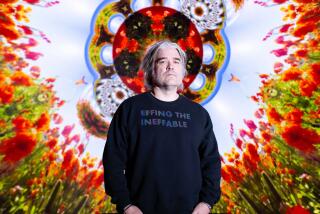DIC Profits Take Off With Tie-In to ‘Photon’ Program
- Share via
Andy Heyward was watching the network news three years ago when he saw a story about a place in Dallas where customers could don Star Wars-style gear, chase each other through a maze of a building and try to shoot other players with weapons that fire infrared beams.
Heyward, president of Encino-based DIC Enterprises, immediately telephoned George Carter III, developer of the game, called Photon. The next day, Heyward was on a plane to Dallas to cut a deal.
The result is a Saturday morning television show that begins with a blast of bright orange, somewhere in outer space, then a swirling light.
“Before there was time,” intones a deep male voice in the introduction, “there was Photon, the crystal energy force that creates and sustains life in our universe.”
“The Warlord of Arr and his evil army are determined to control Photon and use it for their own evil ends,” the voice says. “The only thing that stands in their way is the earthling Bhodi Li who, along with five other Photon champions, are known as”--pregnant pause--”The Photon Warriors.”
Like much of children’s television, the Photon show is in large measure a marketing vehicle for ancillary products. DIC licenses Photon merchandise, including party hats, stickers, lunch boxes, sandals, playhouses, beach towels, flashlights and earmuffs.
It is a route that DIC, which has 50 half-hour shows on the air this season, has traveled before. The company’s “Inspector Gadget” and “Heathcliff” animated series have spawned similar products.
DIC has produced 26 episodes of “Photon,” which has been airing in 65% of U.S. markets since September. It is a “live-action” show, meaning simply it is not animated; the show’s main characters are actors in costume.
DIC’s writers created the story line in keeping with Carter’s idea that it be a “live video game.” Other characters include Parcival, boy genius in a baseball cap, and the alien Dogarr, “with jaws the size of Pittsburgh,” according to the show.
Heyward, 37, is a pretty flashy guy in his own right, sporting several pairs of squarish eyeglasses in different colors, like those worn by rock musician Elvis Costello. He is fond of repeating Carter’s motto, referring to Photon as “the ultimate game on Planet Earth.”
Anyone who wants to get a piece of Photon action--from Gayla Kites of Houston to Burbank-based Disneyland Vista Records, which plans pop-up story books with cassettes or records--must deal with Heyward and DIC. Terms of those arrangements vary and are kept hushed.
$100 Price Tag
Most prominent in stores, and a hot Christmas seller this season, are the pistol-shaped, battery-operated “phaser” weapons, made by MCA’s New York-based LJN Toys unit, which sell in a package with helmets and other gear for more than $100.
Nationwide, there are now 17 Photon centers--carpeted, misty buildings where customers pay $3.50 for 6 1/2 minutes of chasing after each other while weighed down by 14 pounds of electronic equipment, including phasers that emit infrared beams.
The only completed center in Southern California is in Fountain Valley. However, a similar business, called Lazer Maze, recently opened at the Sherman Oaks Galleria. A big difference is that players there shoot at mechanical monsters, not fellow patrons.
Photon says it has 148 franchisees signed up worldwide, including at least three in Los Angeles, and expects about half to be open by the end of 1987. Carter expects to go public by next summer.
The licensed products, aimed at children ages 2 to 11, fit well with the Photon centers, which draw customers from 12 to 24 years old, said Joy Tashjian, DIC’s vice president for merchandising.
‘Little Kids Can Play’
“Little kids can play the games they see their big brothers and sisters getting involved in,” said Tashjian, adding that it is a good way to create customers. Because of the heavy equipment participants wear at Photon centers, players must be taller than 4-foot-6.
The show is tied to the centers in other ways. The Bhodi Li character, played by actor Christopher Lockwood, is a regular suburban teen-ager who can only become a Photon warrior when he shouts out “The Light Shines” after bicycling to a Photon center in a mini shopping mall.
The shows themselves have save-the-Earth-from-blowing-up plots. In a recent episode called “Space Terror,” Bhodi Li accompanied by human as well as animal and lizard-like friends, protects Earth from a kind of Black Hole threatening to swallow it.
Bhodi Li gets a kiss from a veiled girl named Tivia, who generally does not like men, then boards his spaceship to attack the black hole with--what else?--a big blast of light from energized Photon crystals.
As on television shows for grown-ups, like “Miami Vice,” rock music is interspersed through the program in long segments without dialogue. Bhodi Li flies toward the black hole to the tune of Robert Palmer’s “Addicted to Love.”
Live Action Cheaper
Heyward said live-action television shows, which now account for 20% of DIC’s programming, are generally cheaper to produce, and are part of a growing trend in children’s television programming.
DIC has been experimenting with expanding beyond what has been its mainstay, the world of kids, by producing Home Box Office’s often violent “Hitchhiker” series this season.
DIC, a subsidiary of Radio-Television Luxembourg, a privately held entertainment conglomerate, has grown dramatically since its inception nearly four years ago. Starting as a company of three people based in the kitchen of Heyward’s mother, it now has more than 300 staff members.
The company does not reveal profits. But, based on bookings in hand, Heyward said, the company should have about $60 million in sales this year, slightly ahead of 1985.
More to Read
The biggest entertainment stories
Get our big stories about Hollywood, film, television, music, arts, culture and more right in your inbox as soon as they publish.
You may occasionally receive promotional content from the Los Angeles Times.










